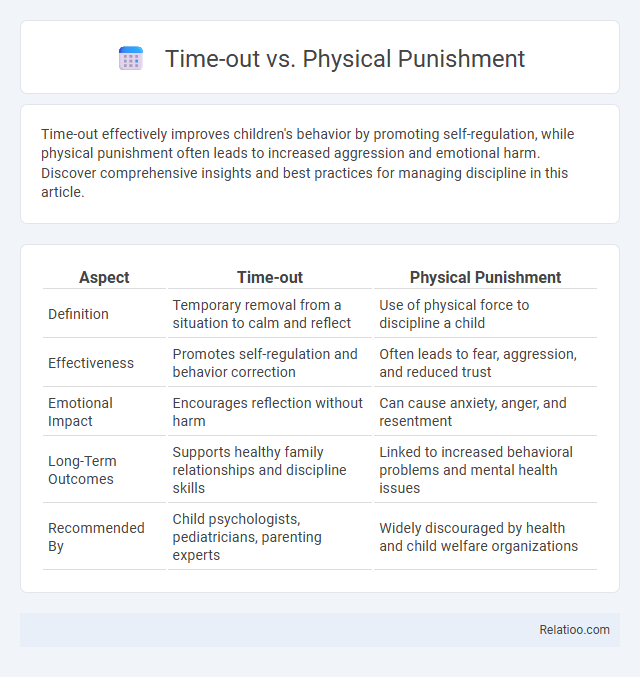Time-out effectively improves children's behavior by promoting self-regulation, while physical punishment often leads to increased aggression and emotional harm. Discover comprehensive insights and best practices for managing discipline in this article.
Table of Comparison
| Aspect | Time-out | Physical Punishment |
|---|---|---|
| Definition | Temporary removal from a situation to calm and reflect | Use of physical force to discipline a child |
| Effectiveness | Promotes self-regulation and behavior correction | Often leads to fear, aggression, and reduced trust |
| Emotional Impact | Encourages reflection without harm | Can cause anxiety, anger, and resentment |
| Long-Term Outcomes | Supports healthy family relationships and discipline skills | Linked to increased behavioral problems and mental health issues |
| Recommended By | Child psychologists, pediatricians, parenting experts | Widely discouraged by health and child welfare organizations |
Understanding Time-Out: Definition and Purpose
Time-out is a disciplinary technique designed to temporarily remove a child from a reinforcing environment to reduce unwanted behavior, promoting self-regulation and reflection. Unlike physical punishment, which can cause harm and fear, time-out emphasizes non-violent consequences aimed at teaching appropriate behavior. Your effective use of time-out supports healthy emotional development by providing clear boundaries without physical or psychological damage.
What is Physical Punishment? Key Concepts
Physical punishment involves the deliberate use of bodily force intended to cause some degree of pain or discomfort as a method of discipline, including actions like spanking, slapping, or hitting. Key concepts emphasize that physical punishment can lead to negative psychological effects and increased aggression in children, contrasting with alternative disciplinary strategies such as time-out, which promote self-regulation without physical harm. Research consistently highlights the correlation between physical punishment and long-term behavioral problems, underscoring the importance of non-violent discipline approaches.
Historical Perspectives on Child Discipline
Historical perspectives on child discipline reveal a gradual shift from physical punishment to more structured methods like time-outs and verbal punishment. Physical punishment was once widely accepted as a primary disciplinary tool, reflecting societal norms that endorsed corporal punishment for obedience. You can observe that contemporary approaches emphasize time-out techniques, which promote behavioral correction without physical harm, aligning with modern psychological insights and child development research.
Psychological Effects of Time-Out
Time-out is a disciplinary technique that removes a child from a reinforcing environment to decrease unwanted behavior, showing fewer negative psychological effects compared to physical punishment. Research indicates time-out reduces aggression and anxiety while promoting self-regulation by providing a calm space for emotional control. In contrast, physical punishment is linked to increased aggression, antisocial behavior, and long-term psychological harm, making time-out a preferred method in positive behavioral interventions.
Impact of Physical Punishment on Child Development
Physical punishment, including actions like spanking, is linked to increased aggression, anxiety, and antisocial behavior in children according to multiple psychological studies. Time-out methods promote self-regulation and emotional control by providing a structured break from negative behavior, contrasting with punishment approaches that may harm parent-child relationships. Expert organizations such as the American Academy of Pediatrics recommend avoiding physical punishment due to its detrimental effects on brain development and long-term mental health outcomes.
Comparing Effectiveness: Time-Out vs Physical Punishment
Time-out is generally more effective than physical punishment in promoting long-term positive behavior changes because it encourages self-regulation without instilling fear or aggression. Research shows that time-outs help children learn consequences calmly, reducing the likelihood of emotional harm and behavioral problems, whereas physical punishment is often linked to increased aggression and mental health issues. Experts recommend time-outs as a safer, evidence-based discipline strategy that fosters emotional development and respectful parent-child relationships.
Long-Term Consequences for Children
Time-out is associated with promoting self-regulation and emotional understanding in children, leading to healthier long-term behavioral outcomes compared to physical punishment. Physical punishment often correlates with increased aggression, anxiety, and diminished parent-child trust, negatively impacting a child's emotional development and social skills over time. Consistent, non-physical punishments that emphasize reasoning and reinforcement tend to foster better cognitive growth and resilience, shaping more adaptive adult behaviors.
Expert Recommendations and Guidelines
Expert recommendations emphasize time-out as a more effective and psychologically safe discipline method compared to physical punishment, minimizing risks of aggression and anxiety in children. Leading organizations like the American Academy of Pediatrics advocate for time-out over punishment forms involving physical force, highlighting its role in promoting self-regulation without fear or harm. Guidelines consistently discourage physical punishment due to associations with negative developmental outcomes and favor positive behavioral interventions that reinforce desired behaviors.
Positive Discipline Alternatives
Time-out, physical punishment, and traditional punishment differ significantly in their effects on child development, with positive discipline alternatives promoting healthier emotional growth. You can foster cooperation and self-regulation through techniques like time-in, natural consequences, and clear communication, which emphasize understanding and respect rather than fear or compliance. Positive discipline encourages long-term behavioral change by teaching empathy and problem-solving skills, avoiding the negative impacts associated with physical or punitive methods.
Making Informed Choices: Parents and Caregivers
Parents and caregivers must weigh the effectiveness and long-term impact of time-out, physical punishment, and other forms of punishment when addressing child behavior. Research consistently shows that time-out, as a non-violent disciplinary method, promotes self-regulation and reduces aggression more effectively than physical punishment, which is linked to increased behavioral problems and emotional issues. Making informed choices involves prioritizing evidence-based strategies that foster positive development and maintain safe, respectful relationships between adults and children.

Infographic: Time-out vs Physical Punishment
 relatioo.com
relatioo.com